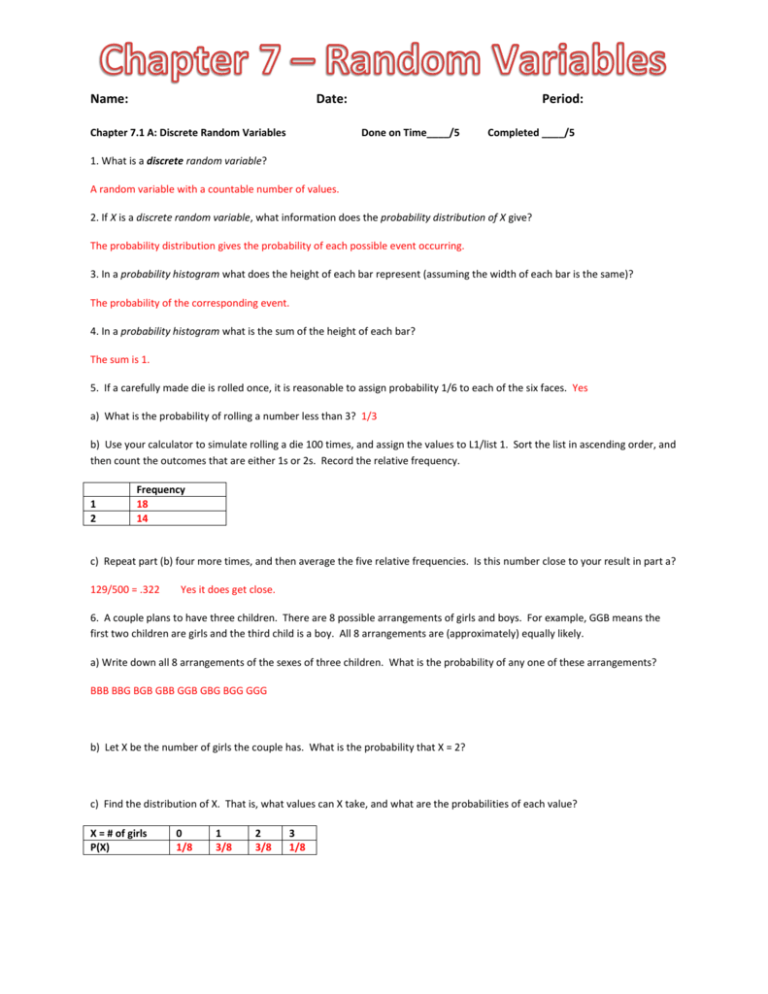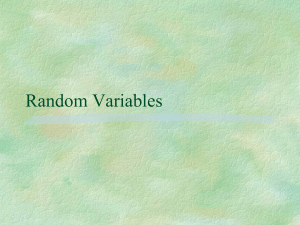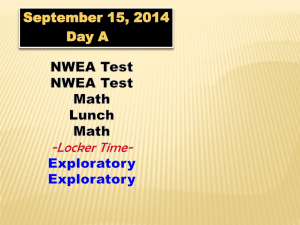7.1 A Solutions - JuabMath
advertisement

Name:
Date:
Chapter 7.1 A: Discrete Random Variables
Period:
Done on Time____/5
Completed ____/5
1. What is a discrete random variable?
A random variable with a countable number of values.
2. If X is a discrete random variable, what information does the probability distribution of X give?
The probability distribution gives the probability of each possible event occurring.
3. In a probability histogram what does the height of each bar represent (assuming the width of each bar is the same)?
The probability of the corresponding event.
4. In a probability histogram what is the sum of the height of each bar?
The sum is 1.
5. If a carefully made die is rolled once, it is reasonable to assign probability 1/6 to each of the six faces. Yes
a) What is the probability of rolling a number less than 3? 1/3
b) Use your calculator to simulate rolling a die 100 times, and assign the values to L1/list 1. Sort the list in ascending order, and
then count the outcomes that are either 1s or 2s. Record the relative frequency.
1
2
Frequency
18
14
c) Repeat part (b) four more times, and then average the five relative frequencies. Is this number close to your result in part a?
129/500 = .322
Yes it does get close.
6. A couple plans to have three children. There are 8 possible arrangements of girls and boys. For example, GGB means the
first two children are girls and the third child is a boy. All 8 arrangements are (approximately) equally likely.
a) Write down all 8 arrangements of the sexes of three children. What is the probability of any one of these arrangements?
BBB BBG BGB GBB GGB GBG BGG GGG
b) Let X be the number of girls the couple has. What is the probability that X = 2?
c) Find the distribution of X. That is, what values can X take, and what are the probabilities of each value?
X = # of girls
P(X)
0
1/8
1
3/8
2
3/8
3
1/8
7. Spell-checking software catches “non-word errors,” which result in a string of letters that is not a word, as when “the” is
typed “teh.” When undergraduates are asked to write a 250 – word essay (without spell-checking), the number X of non-word
errors has the following distribution:
Value of X
Probability
0
0.1
1
0.2
2
0.3
3
0.3
4
0.1
a) Write the event “at least one non-word error” in terms of X, or write this using symbolic notation. What is the probability of
this event?
𝑃(𝑋 ≥ 1) = 0.9
b) Describe the event 𝑋 ≤ 2 in words. What is the probability? What is the probability that 𝑋 < 2?
There is at least 2 non-word errors = 0.6, less than 2 = 0.3
8. How do rented housing units differ from units occupied by their owners? Here are the distributions of the number of rooms
for owner-occupied and renter occupied units in San Jose California?
Owned
Rented
1
0.003
0.008
2
0.002
0.027
3
0.023
0.287
4
0.104
0.363
Number of Rooms
5
6
0.210
0.224
0.164
0.093
7
0.197
0.039
8
0.149
0.013
9
0.053
0.003
10
0.035
0.003
a) Make probability histograms of these two distributions, using the same scales. What are the most important differences
between the distributions of owner–occupied and rented housing units?
b) Let the random variable X be the number of rooms in a randomly chosen owner-occupied housing unit in San Jose, California.
Express “the unit has five or more rooms” in terms of X. What is the probability of this event?
c) Express the event {𝑋 > 5} in words. What is its probability?
d) What important fact about discrete random variables does comparing your answers to b) and c) illustrate?






